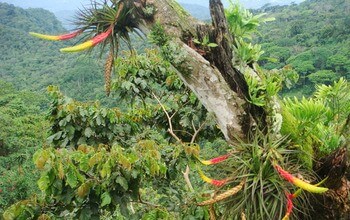Wonder why that cup o’ joe is so expensive?
The culprit, says ecologist Ivette Perfecto of the University of Michigan, is a fungus sweeping through coffee plantations in Mexico and Central America, limiting coffee production and pushing prices higher.
Guatemala, Honduras and Costa Rica have declared national emergencies as a result of the disease, caused by a fungus called coffee rust (Hemileia vastatrix). The current outbreak is the worst since the fungus arrived in the region 40 years ago.
Coffee production in Guatemala alone could drop by 40 percent, farmers there believe. With Central America supplying some 15 percent of the world’s coffee, the blight could make your favorite espresso drink a costly treat.
Coffee is one of the most traded commodities in the world. It provides support for millions of small farmers and is an important economic engine in tropical countries–more than 20 in Latin America alone.
“It’s hard to overstate the social and economic importance of coffee–it literally touches our lives every day,” says Doug Levey, a program director in the National Science Foundation’s (NSF) Division of Environmental Biology, which funds Perfecto’s research on the ecology of coffee plantations.
Out of Africa and onto the world’s coffee farms
The trouble started a century and a half ago near Lake Victoria in Africa, where coffee rust first appeared. It soon found its way throughout the coffee-growing areas of Africa and into Southeast Asia. By 1970, coffee rust had jumped to Brazil.
“It became so devastating in Sri Lanka, southern India and Java that coffee agriculture had to be abandoned,” says Perfecto.
Now coffee rust has spread to every coffee-growing country in the world. The spores of the fungus hitch a ride on winds and are dislodged from coffee plant leaves by rains.
The trend away from traditional coffee-growing techniques, in which coffee plants are placed beneath tall shade trees, may be the root of the problem, say Perfecto and colleague John Vandermeer, also an ecologist at the University of Michigan.
The scientists have conducted research at an organic coffee plantation in Chiapas, Mexico, for more than a decade. They’re studying the complex web of interactions among the coffee rust fungus and insects, as well as birds and bats.
More than 60 percent of the coffee plants on their research site are defoliated as a result of the rust, which affects the plants’ leaves by halting photosynthesis. Many plants are leafless; some have died.
A need for shade
Farmers are reducing the number of shade trees on their plantations, says Perfecto. In an attempt to increase production, they’ve moved to sun coffee, in which the tree canopy is removed or thinned.
“Coffee farmers are also relying more heavily on pesticides and fungicides to manage threats to their plants,” Perfecto says.
The rampant use of such methods has led to concerns about how to vanquish coffee rust. “Control is probably best accomplished by promoting the ecological balance between the fungus that causes the disease and the organisms that naturally rein it in,” says Levey.
In the web of life on coffee farms, lack of shade may have contributed to the die-off of another fungus, called white halo fungus (Lecanicillium lecanii). White halo is the “good witch” of coffee plantations, doing battle with coffee rust–and winning. If white halo fungus isn’t around to zap it, coffee rust runs riot.
“This once-complex system is breaking down,” says Perfecto. “You can’t grow coffee as though it’s a sun crop like corn. Coffee plants naturally live in the shade.”
In the past, the complexity of the coffee plant ecosystem likely acted as a buffer against epidemics of coffee rust. An association between the ant Azteca instabilis and another coffee pest, green coffee scale (Coccus viridis), plays a part.
Four species–coffee rust, white halo fungus, green coffee scale and the Azteca ant–“are embedded in a system of ecological interactions,” says Perfecto. The ants depend upon green coffee scale; green coffee scale is in turn “food” for white halo fungus; white halo then attacks coffee rust.
To combat the rust, says Perfecto, a farm needs all three–white halo fungus, green coffee scale and Azteca ants. These defenders fare best in their natural habitat: under a shady canopy.
Back to nature on a coffee farm
“This research reveals a surprisingly natural ecosystem nested within a major agricultural crop,” says Levey. “It demonstrates that an ‘agroecosystem’ can be used as a model to study the natural control of plant diseases that threaten crop production.”
The interactions between agricultural and natural ecosystems are increasingly important to both, Perfecto believes. “Natural systems provide organisms that pollinate and control pests on crops, and farms can support a diversity of native species that co-exist with agriculture,” she says.
But this mutual benefit depends on how farms are managed: intensive agriculture may not be sustainable, but less aggressive farming methods–a lighter human footprint on the land–may, in the long run, yield more and better crops.
In the case of coffee rust, fewer canopy trees cut down would be a major step forward, say Perfecto and Vandermeer.
Bring back the shade, they say, and the Azteca ants, green coffee scale and the white witch–white halo fungus–of the coffee plantation will reappear. Coffee rust: be gone!

